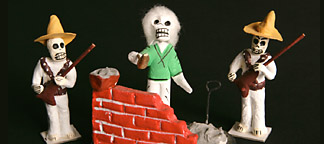  |
|
On the altar Altar for the Border October 15 through November 6 4 - 8pm, Wed - Fri; 2 - 8pm, Sat & Sun 5555 Morningside, Suite 204 Houston, TX 77005 (713) 521-3686 Event Information The altar (a Day of the Dead tradition in Mexico) is dedicated to women who are victims of escalating violence in the Lower Rio Grande Valley and its contents help raise awareness of issues on the US-Mexico border. While many people who are affected by the current wave of violence have lived on the border for many years, many more have migrated to the border in recent years looking for work in the maquiladora industry. For migrants altars have added meaning as they are often unable to visit family gravesites in the communities where once permanently settled. On the Altar Portraits of young Mexican-American victims Women face particular perils on the US-Mexico border, including violent assault, kidnapping, rape and murder. The numbers of women missing or found murdered in border cities on the South Texas-Northeast Mexico border has not been confirmed, but the rates of violence against women over the past year appear to be rising more rapidly than the kidnappings and serial killings in Juarez. The violence is attributed to drug trafficking cartels and local gangs, and others involved in the dispute for territorial control and power. Traditional items The altar features items traditionally placed on Day of the Dead altars, including water (to sustain life and purify the soul), bread, salt, rice and beans (which are now delivered by charitable organizations as populations of unemployed and underpaid workers have little means to provide for their families), and fruit (grapefruit is a major product of the Lower Rio Grande Valley). Marigolds and other colorful flowers are usually placed on altars for adults, but white flowers are often placed on the altars for children and sometimes young adults. Religious items A cross and Virgin of Guadalupe are included for the many deeply religious people who have lived peacefully in the border region of northern Tamaulipas and South Texas for decades. Candles are for beliefs, hope or guidance. On many altars, rows of candles are arranged in the form of a lighted path to help the spirit of the deceased return to the home and to find the offerings left on the altar. Other altars may display candles in the form of a cross, or an 'X' to represent the four directions. Baskets and vessels have special significance in the indigenous heritage of many Mexican and Mexican-American people. Gourds and rattles (a tourist Maraca is used on this altar) are sacred items in some indigenous religious practices. Garlic is a trade product of Mexico and also believed to keep away evil spirits. Copal or other burning incense is more likely to be placed on altars for protection throughout central and southern Mexico. Trade goods Goods have been traded across the region for many centuries. The Border Industrialization Plan brought large assembly plants (maquiladoras) to the region in 1965. One of the highest concentrations of factories in Mexico is now located in cities on the Mexican side of the border along the Lower Rio Grande Valley, from Matamoros to Nueva Laredo. The constant demand for cheap labor to meet United States consumers' desire for lower prices has created overwhelming poverty in the region. In addition to environmental and health concerns, issues of labor abuse are reminiscent of conditions that resulted from the Industrial Revolution and Great Depression. Coin offerings on the altar remind us that relief work is in high demand in many colonias on both sides of the border, while dollars and pesos represent the devaluating peso, and some economic effects that can be tied to NAFTA (North American Free Trade Agreement, which went into effect in 1994; results included the Zapatista rebellion in Chiapas and a sudden drain on the Mexican economy by U.S. corporations). While the labor conditions on the border originated with the Border Industrialization Plan three decades earlier, NAFTA exacerbated many problems for the poor, including devaluated labor (fewer constraints on production, decreased wages, high unemployment) and increased cost of living. Hand-carved indigenous toy dolls represent the handmade traditional crafts and trade goods of indigenous populations, while plastic toys (made in maquiladoras) represent cheaply made mass-produced products. Many of the office products, electronics, toys, household utensils, and more everyday consumables are made and/or assembled by maquiladora workers. Many of the Mexican women who have been victimized in the border region are maquiladora workers who work odd hours, travel desolate roads to their jobs, and live and travel in unlighted areas during the late night and early morning. But the indiscriminate violence has affected women who experience a wide variety of living conditions on both sides of the border. Learn more about what you can do to help: houstonculture.org/border/help |
| TRADITIONS OF MEXICO PROJECT OVERVIEW HOUSTON INSTITUTE FOR CULTURE |